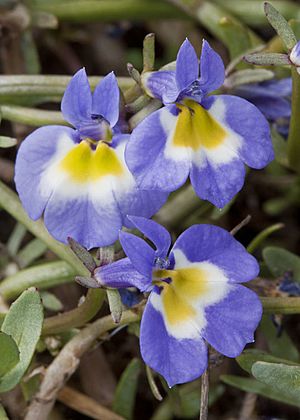Hoover's calicoflower facts for kids
Quick facts for kids Hoover's calicoflower |
|
|---|---|
 |
|
| Scientific classification | |
| Genus: |
Downingia
|
| Species: |
bella
|
Downingia bella, also known as Hoover's calicoflower or Hoover's Downingia, is a beautiful wild plant. It belongs to the Bellflower Family, which is called Campanulaceae by scientists. This plant's scientific name, Downingia, honors A.J. Downing. He was a famous American expert in gardening and designing landscapes from 1815 to 1852.
This plant is a type of annual herb. This means it grows from a seed, flowers, produces new seeds, and then dies all within one year. Downingia bella is special because it is endemic to California. This means it naturally grows only in California and nowhere else in the world. You can find it in grassy areas, especially in vernal pools. These are temporary ponds that fill with water in winter and spring, then dry up in summer.
Downingia bella usually grows in these wetland areas, found at elevations between 4,600 and 5,250 feet (1,400 to 1,600 meters). Sadly, about 20% of California's vernal pools have disappeared. Because of this, Downingia bella is not very common. You can find it scattered in different parts of California. Its range stretches from Riverside County all the way to areas in the Great Central Valley.
Contents
What is Hoover's Calicoflower?
Hoover's calicoflower is a unique plant that loves wet places. It's an annual herb, meaning it completes its whole life cycle in just one year. It grows from a seed, blooms with pretty flowers, makes new seeds, and then dies. This plant is a true Californian, found only in its home state.
Where Does it Grow?
This special plant thrives in specific habitats. It loves vernal pools, which are like natural puddles that appear in winter and spring. These pools fill up with rainwater and then dry out as the weather gets warmer. Downingia bella needs these temporary wet spots to grow.
It grows in grassy areas, usually at high elevations. Because many of these vernal pools have been lost, Downingia bella is now quite rare. It's important to protect these areas so this unique plant can continue to grow.
How to Spot It: Description
Like all plants in the Downingia group, Hoover's calicoflower has a stem that can either lie flat on the ground or stand upright. Its leaves grow along the stem. Often, these leaves fall off before the plant's flowers even open!
Flower Features
The flowers of Downingia bella grow in a cluster, like a spike. Each flower is about 10 to 12 millimeters long. The flower has two distinct parts, like lips. The upper lip has two narrow, pointed sections. The lower lip has three wider, blunt sections that are slightly toothed.
The flowers are a beautiful blue color. The lower lip has a white area in the middle. Inside this white area, you'll see two yellow spots. These yellow spots might even be joined together. Right at the center of the flower, where the "lips" meet, there are two raised bumps. These bumps usually have three purple spots that alternate with each other, making the flower even more interesting!
Inside the Flower
Inside the flower, there are five parts called stamens. These are the parts that produce pollen. They are joined together and are tucked inside the flower's tube. The plant also has an ovary, which is where the seeds will form. This ovary is located below the flower's petals.
Fruits and Seeds
After the flower blooms, it produces fruits. These fruits are about 16 to 18 millimeters long. They have tough sides and open slowly to release the seeds. The seeds inside the fruit have tiny lines running along them.
Sometimes, in certain areas of northern Sutter County, you might find Downingia bella flowers with a tiny horn-like shape on their petals. This is similar to another plant called D. ornatissima.

